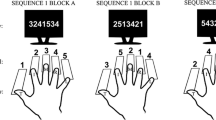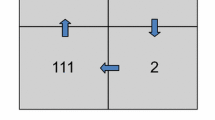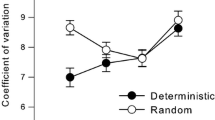Summary
Many motor skills involve a sequence of movements phased over a period of time. The present study investigated the importance of rhythmic timing structures in the acquisition and control of a serial key-pressing task. Four groups of subjects received extensive practice on 9-element finger sequences varying in the form of the inherent temporal structure. Following a training period, the stability of the various timing patterns was examined by requiring subjects to perform the key-pressing task concurrently with a verbal memory task. The memory task involved reporting back a sequence of visually-presented words with a lag of one word. A comparison was made of performance on the two tasks under dual task and control (single task) conditions. The results suggested that “natural” rhythmic timing structures require less attention for production than “unnatural” temporal patterns. A breakdown of the temporal patterns into “within-group” and “between-group” intervals showed that patterns containing within-group intervals that related as 1:1 or 1:2 evidenced good stability under dual-task conditions. These results were taken as support for the suggestion by Fraisse (1946) that the perception and production of rhythms can be understood by an internal representation that allows only two distinct durations that relate as 1:2. Furthermore, it was suggested that relative timing may become an invariant property of motor program representation only in those instances in which the timing sequence completely fits the internal timing structure.
Similar content being viewed by others
References
Fraisse, P. (1946). Contribution à l'étude du rhythme en tant que forme temporelle. Journal de Psychologie Normale et Pathologique, 39, 283–304.
Fraisse, P. (1956). Les structures rhythmiques. Louvain: Publications Universitaires de Louvain.
Fraisse, P. (1963). The Psychology of Time. New York: Harper.
Fraisse, P. (1978). Time and rhythm perception. In E.C. Carterette & M.P. Friedman (Eds.). Handbook of Perception, (Vol. 8), pp. 203–254. New York: Academic Press.
Martin, J.G. (1972). Rhythmic (hierarchical) versus serial structure in speech and other behaviour. Psychological Review, 79, 487–509.
Povel, D.J. (1981). Internal representation of simple temporal patterns. Journal of Experimental Psychology: Human Perception and Performance, 7, 3–18.
Summers, J.J. (1975). The role of timing in motor program representation. Journal of Motor Behavior, 7, 229–241.
Author information
Authors and Affiliations
Rights and permissions
About this article
Cite this article
Summers, J.J., Sargent, G.I. & Hawkins, S.R. Rhythm and the timing of movement sequences. Psychol. Res 46, 107–119 (1984). https://doi.org/10.1007/BF00308596
Issue Date:
DOI: https://doi.org/10.1007/BF00308596




